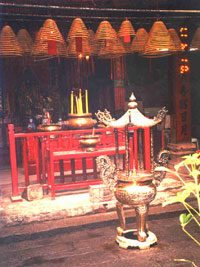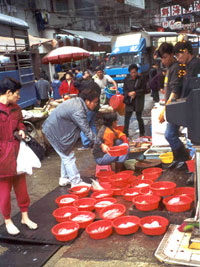Welcome to Malaysia
Everywhere in Kuala Lumpur, one sees the sharp contrast between ultramodern glass-and-steel skyscrapers and decrepit old wood-frame buildings. Shiny new luxury cars pull up at five-star hotels, while most cars are ancient. Giant cranes dot the skyline. Ten-foot-high steel fences hide slums, which of course are visible from upper floors of the luxury hotels. To me, it's a poor country pretending to be rich. “It's been that way for at least fifteen years,” said a Canadian living in Thailand. Hopefully, Malaysia will not be another Philippines. Approaching the city by train, you see mile after mile of shacks with chickens, goats and dogs running loose, trash heaps and garbage strewn about. Suddenly you're surrounded by skyscrapers, wondering what happened, and you glide into the ultramodern railway station where women in traditional clothing line up at McDonald’s.

Only 800 people a day are allowed up on the crosswalk at the Petronas Towers due to engineering concerns, so you must arrive early in the morning. To me, the towers—now a national symbol—are ugly. I wonder how many Malaysians have visited them. Probably a small percentage. At the cultural center, I could not attend a concert because I was wearing sandals. So I walked to Menera Tower, where the observation deck is open all day (You need a reservation to enter the restaurant.). The views are great, but they are much like towers everywhere, with a cafeteria and gift shop.
The Bird Park in KL doesn't match the standard of Singapore’s, but it does have many parrots and other birds zooming around under the wire mesh. Walking on a path, I felt a sharp peck on my left foot and was shocked to see a peacock, its feathers fully spread, attacking me. Perhaps its young were nearby. I hastened backward but the angry bird rushed toward my foot again. I took off my pack and held it out, but it jumped onto my pack and attempted to peck my arm. So I walked backward as fast as I could. The peacock finally gave up.
In Malacca a few days later, a white South African friend and I were looking for the Information Center. Someone said, “It's there” pointing to the Police Department. We walked in hesitantly, and two uniformed officers asked, “May we help you?” “Yes, we're looking for St. Paul's Church.” “Let me show you on a map.” This depot is called, “Tourist Police,” which raised a few questions in my mind: Do the Tourist Police protect tourists? If so, why? Or do they protect citizens from tourists? Outside, a huge sign reads, "Melaka Tourist Police Bamboo Shoot Café.” Such a sign in the U.S. would not remain in place more than 24 hours; a private business using a government endorsement would result in court injunctions and lawsuits. I wonder how the owner of a competing café feels about it; maybe he isn’t wealthy enough for his own Tourist Police sign.
On a river tour in Malacca, our guide apologized for the dirty water, saying, “The government has asked people not to throw trash into the river, but unfortunately they continue to do so. I hope you will see improvement if you return after four years.” Why four years? I thought, “It's not only trash they, and factories, are throwing into the water, my friend. He pointed out mudfish and lizards slinking out of the water, onto broken walls and trees. We saw dilapidated buildings and piles of trash at every turn. The guide told us stories and made jokes, as if these sights were wonderful. Seeing black sludge flowing into the brown water, we were amazed that Malaccan officials would actually run a tour there without first doing something to clean it up.
If you go to Malacca, I strongly recommend the Museum of Beauty at the People's Museum. It addresses the concept of beauty in tribal cultures around the world, from antiquity to modern times. A plaque reads, “Enduring beauty has a dual meaning: on the one hand, beauty is lasting and permanent. But it also refers to pain and suffering. Paradoxically, beauty is not enduring; it fades, and concepts change. This exhibit covers prehistoric times to the present, in nearly every country on Earth.” In the foot-binding display, you learn precisely how to wrap a foot, how to bathe it every other day and rebind it. Women with bound feet were totally dependent on servants and their husbands. What appeared to be a tiny foot was really the big toe, with the rest of the foot hidden and the arches folded so that the ball of the foot touched the heel. This practice existed in many countries in Southeast Asia.

Other forms of bodily enhancement are exhibited, such as scarification, dental mutilation and tattooing—not merely partial tattooing, but full-body tattooing, which is so dangerous and painful that some died from infections. One exhibit focuses on the “giraffe women” of Myanmar who, when shown x-rays of their upper bodies, could not believe their eyes. A full set of twelve brass rings weighs up to eighty pounds, and a giraffe woman’s shoulders and ribs are pressed down like branches of a pine tree. Rings are also worn on the ankles and wrists. The process begins at age five, with the ceremonial installation of the first ring. Through the girl’s teens, rings are gradually added. Punishment for an adulterous woman consists of removal of her neck rings, because she must then hold her head in her hands, or if her husband permits, wear a brace. Giraffe women need special pillows at night. In the adjoining room you can learn about Susuk, the hidden charm needles inserted by bomohs—medicine men. Since this practice is forbidden by Islam as a "mystic art," most wearers deny knowledge of it—but Malaysian dentists have found them in X-rays. The Museum of Beauty, in my view, is not about beauty but subjugation of women around the world. For relief, walk upstairs to the Kite Museum, and let your spirit soar on flights of fancy. Warning: there is no air conditioning in the People's Museum, and no bathrooms—the nearest are located at the A&W fast food restaurant across the courtyard.

In Malacca, a young Swedish woman invited me for a swim at the city pool. She told the attendant, "I only have a bikini. It that OK?" "Yes." He asked if I had a swimsuit. Yes, I did. I changed and entered the pool area, upon which a man approached and said, "Sir, you cannot stay without a bathing suit." My trunks were loose-fitting. I said, "This is a bathing suit." "Sir, you must obey the rules.” I asked where I could get an acceptable pair. One of the guards rented to me a tight-fitting black suit, very worn with holes but clean, for RM2 (about thirty cents, U.S.). Women, who must cover their heads outside at all times, can display their bodies at the public pool, and tiny V-shaped suits are acceptable for men. I also received a swimming lesson when the guard noticed that I was not lifting my left arm. He added, "Most Americans are fit! You need to work out—lift weights!”
At The Equator, Malacca's five-star hotel, a server asked me if Washington State is near Chicago or Las Vegas. I've often been surprised by ignorance of American geography. An Australian woman didn't know where New Jersey was. "Why would you expect an Australian to know that?" she asked. "Before you came here, did you know where Adelaide or Brisbane are? Did you know that Tasmania belonged to Australia? Nope! I used to think that Kuala Lumpur was south of Singapore, that Malacca is part of Spain, and that Sarawak is in Indonesia. (It's on the island of Borneo, shared by three countries.) I had never heard of Sabah, one of Malaysia's most popular resorts. Malaysia, the poorest of the countries I visited, posed the greatest challenge to my assumptions. I will return, with open eyes and mind.
